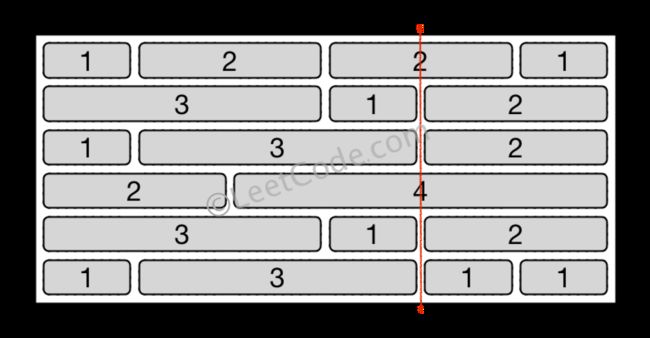Description
There is a brick wall in front of you. The wall is rectangular and has several rows of bricks. The bricks have the same height but different width. You want to draw a vertical line from the top to the bottom and cross the least bricks.
The brick wall is represented by a list of rows. Each row is a list of integers representing the width of each brick in this row from left to right.
If your line go through the edge of a brick, then the brick is not considered as crossed. You need to find out how to draw the line to cross the least bricks and return the number of crossed bricks.
You cannot draw a line just along one of the two vertical edges of the wall, in which case the line will obviously cross no bricks.
Example:
Input:
[[1,2,2,1],
[3,1,2],
[1,3,2],
[2,4],
[3,1,2],
[1,3,1,1]]
Output: 2
Explanation:
Note:
- The width sum of bricks in different rows are the same and won't exceed INT_MAX.
- The number of bricks in each row is in range [1,10,000]. The height of wall is in range [1,10,000]. Total number of bricks of the wall won't exceed 20,000.
Solution
HashMap, time O(mk), space O(wallWidth)
- m: wall height (wall.size())
- k: average bricks count in each row
横穿几个砖头如果不好做的话,不如考虑钻过几个空隙。
class Solution {
public int leastBricks(List> wall) {
Map map = new HashMap<>();
int maxEdges = 0;
for (List bricks : wall) {
for (int i = 0, len = 0; i < bricks.size() - 1; ++i) {
len += bricks.get(i);
map.put(len, map.getOrDefault(len, 0) + 1);
maxEdges = Math.max(map.get(len), maxEdges);
}
}
return wall.size() - maxEdges;
}
}
PriorityQueue, time time O(mk * log m), space O(m)
m: wall height (wall.size())
k: average bricks count in each row
这种解法也挺直观的,比上面解法的好处就是所需要的空间比较小,坏处就是时间复杂度略高一些。
class Solution {
public int leastBricks(List> wall) {
PriorityQueue queue = new PriorityQueue<>((a, b) -> a[2] - b[2]);
for (int i = 0; i < wall.size(); ++i) {
if (wall.get(i).size() > 1) {
queue.offer(new int[] {i, 0, wall.get(i).get(0)});
}
}
int maxEdges = 0;
int len = 0;
int count = 0;
while (!queue.isEmpty()) {
int[] tuple = queue.poll();
if (tuple[2] > len) {
len = tuple[2];
count = 0;
}
maxEdges = Math.max(++count, maxEdges);
if (++tuple[1] == wall.get(tuple[0]).size() - 1) {
continue;
}
tuple[2] += wall.get(tuple[0]).get(tuple[1]);
queue.offer(tuple);
}
return wall.size() - maxEdges;
}
}
